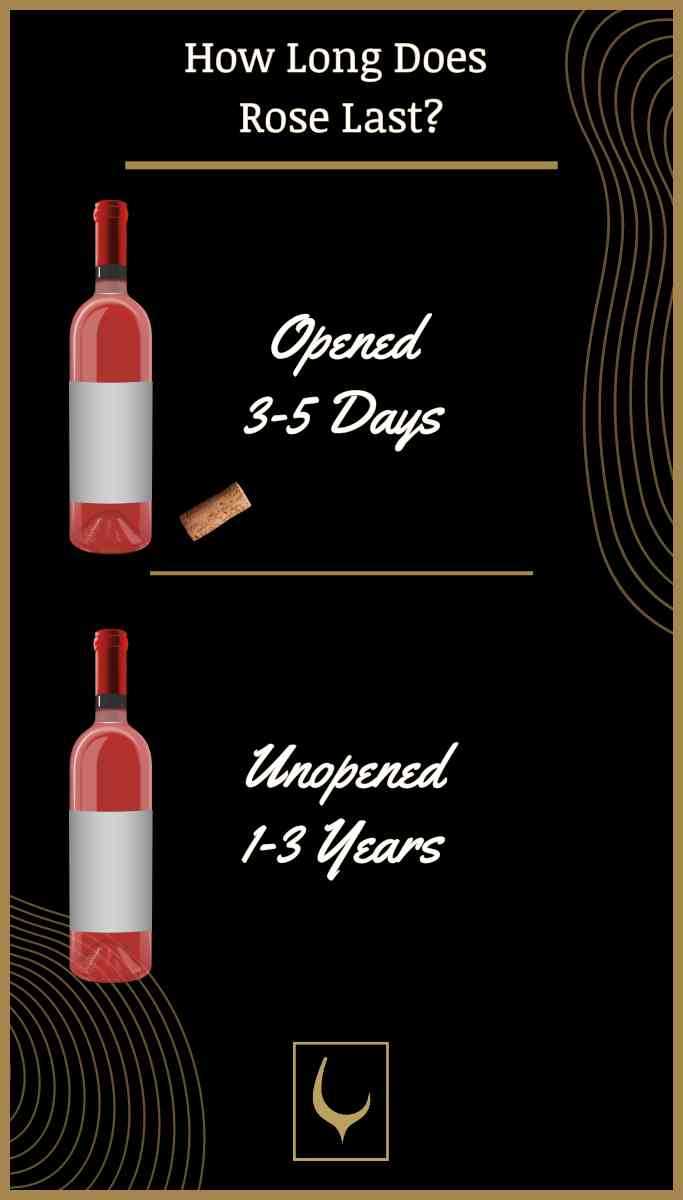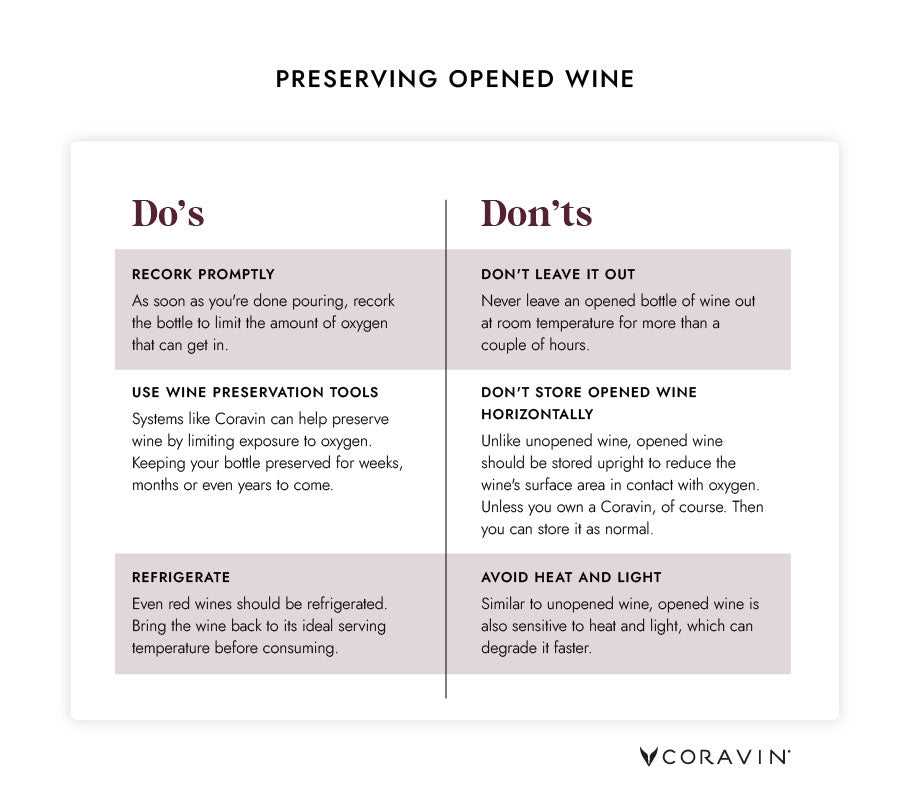



Optimal preservation of an opened bottle requires careful consideration of exposure to air. Allowing it to sit at room temperature for more than a couple of days can lead to oxidation, which diminishes flavor and aroma. Ideally, enjoyed within three to five days, the experience remains vibrant if the bottle is recorked tightly and stored in a cool, dark place.
For those who appreciate a glass now and then, utilizing a vacuum pump to remove excess air is a practical approach. This method significantly slows down the oxidation process. If an extended duration without refrigeration is unavoidable, refrigerating the bottle–even red varieties–can help maintain quality. The cooler temperature slows down chemical reactions, preserving the wine’s character and taste.
Always assess the wine before serving. A change in smell or taste indicates that it may have gone past its prime. Prioritize enjoyment by adhering to these practices, ensuring each glass remains delightful.
Storage of Opened Bottles
Opened bottles should be stored in a cool, dark place, ideally in the refrigerator. This slows down oxidation, preserving the flavors and aromas. For optimal results, recork the bottle tightly or use a wine stopper to minimize air exposure.
Duration of Freshness
Typically, a bottle will remain enjoyable for about 3 to 5 days when properly sealed and stored in a cool environment. Beyond this timeframe, the quality deteriorates, and the taste may become less pleasant.
Signs of Deterioration
Before consuming, check for changes in color and aroma. An off-putting smell or a brownish hue may indicate spoilage. If the taste is flat or sour, it’s best to discard the remaining contents.
Understanding the Oxidation Process in Red Wine

Oxidation occurs when oxygen interacts with compounds in wine, altering its flavor, aroma, and color. Once a bottle is uncorked, exposure to air initiates this chemical reaction, which can enhance certain characteristics in moderation but may lead to spoilage over time.
Effects of Oxidation
Initially, the process can soften tannins and amplify fruity notes, creating a smoother experience. However, prolonged exposure can result in undesirable flavors, often described as flat or vinegary. The color may shift from vibrant red to a dull brown, indicating significant oxidation.
Best Practices for Preservation
To minimize oxidation, consider using a vacuum pump to reduce air in the bottle. Alternatively, transfer the wine to a smaller container to decrease the surface area exposed to oxygen. Storing the bottle upright also helps limit air contact. For those interested in maintaining cleanliness in their wine accessories, learning how to clean the Karcher pressure washer attachments can be beneficial for overall maintenance.
Ultimately, understanding this process can help you enjoy your wine at its best for a longer duration after opening.
Signs of Spoilage in Opened Wine
Identifying spoilage in an opened bottle is crucial for enjoying its full potential. Look for the following indicators:
Visual Changes
Examine the liquid for any sediment or cloudiness. A clear appearance is ideal; cloudiness suggests microbial growth. Additionally, observe the color. If a vibrant hue fades to a brownish tint, oxidation has likely occurred.
Aroma and Flavor Alterations
Smell the beverage. A sour or vinegar-like scent signals spoilage. Fresh, fruity aromas should dominate. Taste it; if the flavor is overly tart or lacks the expected characteristics, it’s past its prime. Ideally, it should still retain its original profile.
Storing opened bottles upright and in a cool, dark place can help maintain quality, but always trust your senses. If any of these signs are present, it’s best to discard the contents.
Optimal Storage Conditions for Opened Red Wine
To maintain the quality of an opened bottle, store it in a cool, dark place with a consistent temperature between 55°F and 65°F. Avoid areas with fluctuating temperatures or direct sunlight.
Utilizing a Wine Stopper
Using a wine stopper or vacuum pump can significantly reduce oxidation. These tools create an airtight seal, limiting exposure to oxygen, which helps preserve the flavor profile.
Refrigeration Benefits
Refrigerating opened bottles can be beneficial. Although it may seem counterintuitive, cooler temperatures slow down the oxidation process. Just remember to let it warm up slightly before serving, as serving at room temperature often enhances the tasting experience.
How Long Can Opened Red Wine Last Outside the Fridge?
Opened bottles can maintain their quality for approximately 3 to 5 days if stored at room temperature. However, this duration heavily relies on factors such as the wine’s type, tannin structure, and exposure to air. Wines with higher tannins typically fare better, as they are more resilient to oxidation.
Factors Affecting Longevity
Temperature plays a significant role. Ideally, maintaining a cooler ambient temperature helps preserve the wine’s character. Exposure to sunlight and fluctuating temperatures can expedite spoilage. Ideally, keep the bottle in a dark place and away from heat sources.
Practical Tips
For optimal preservation, recork the bottle tightly or use a wine stopper designed to reduce oxidation. If you anticipate not finishing a bottle, consider transferring the remaining liquid into a smaller container to minimize air exposure. Remember, once the cork is removed, the clock starts ticking on freshness.
Tips for Preserving the Quality of Opened Wine
Utilize a vacuum pump to remove excess air from the bottle, significantly slowing down oxidation. This method can extend the life of the beverage for several days.
Storing the bottle upright minimizes the wine’s exposure to oxygen. This is particularly beneficial for those that are not corked tightly.
Temperature Control
Maintain a cool environment, ideally between 55°F and 65°F (13°C to 18°C). Avoid fluctuations in temperature, which can adversely affect flavor profiles.
Use of Wine Preservation Products
Consider using inert gas wine preservers. These products displace oxygen in the bottle, creating a protective barrier that preserves taste.
| Technique | Description | Duration of Preservation |
|---|---|---|
| Vacuum Pump | Removes air from the bottle | 3-5 days |
| Upright Storage | Reduces oxygen exposure | 3-5 days |
| Inert Gas Preserver | Creates a gas barrier | 1-2 weeks |
Regularly check for changes in aroma and taste. If the beverage starts to lose its character, it’s time to enjoy the remaining contents.
When to Discard Opened Red Wine: Key Indicators

Evaluate the sensory attributes of your beverage. If you encounter a sour or vinegar-like aroma, it’s time to say goodbye. A sharp, unpleasant scent indicates that spoilage has occurred.
Observe the visual characteristics. Any significant changes in color, such as browning or cloudiness, suggest deterioration. A cloudy appearance often points to microbial activity.
Taste is another critical factor. If the flavor profile has shifted to a flat or overly acidic note, it’s best to discard the bottle. Freshness is crucial for a delightful experience.
Check for bubbles or fizz in still varieties. This effervescence is a sign of unwanted fermentation. If carbonation is present, it’s advisable to dispose of the contents.
Consider the duration since the cork was removed. If more than three to five days have passed without proper storage, the quality has likely diminished significantly.
- Off odors: vinegar, sourness, mustiness
- Visual changes: cloudiness, browning
- Flat or overly acidic taste
- Unwanted carbonation in still wines
- Time elapsed since opening
Trust your senses. When in doubt about the quality, it’s safer to discard. Enjoying a beverage at its peak is always preferable to risking an unpleasant experience.







